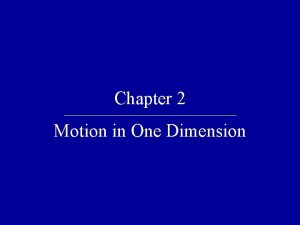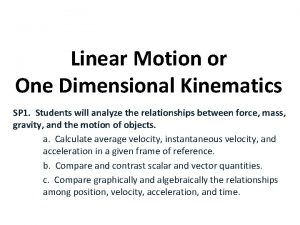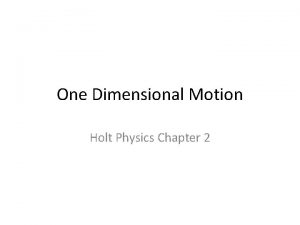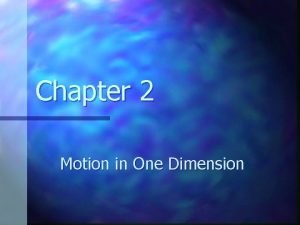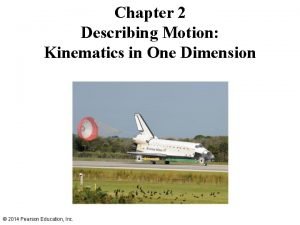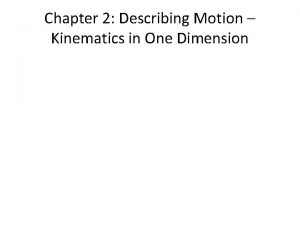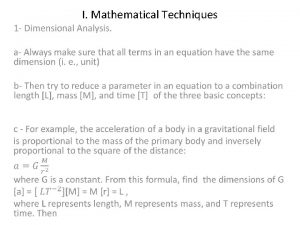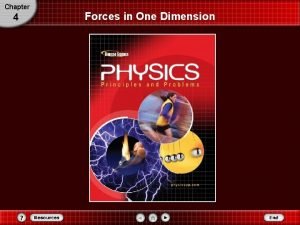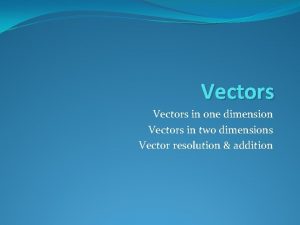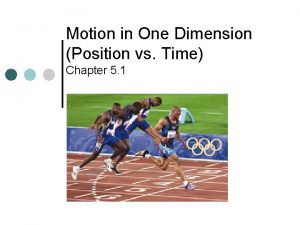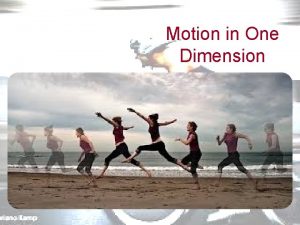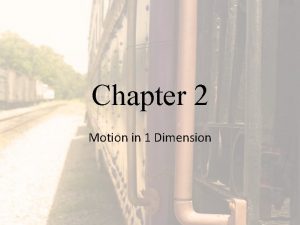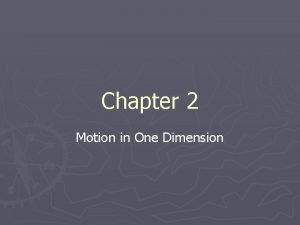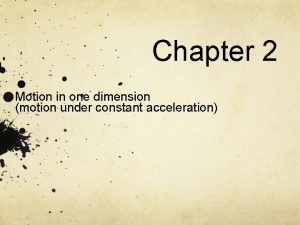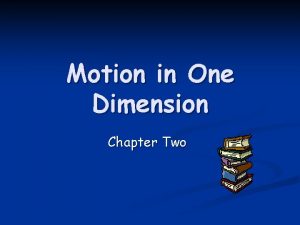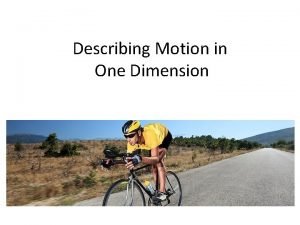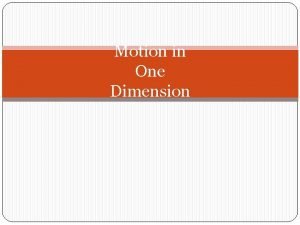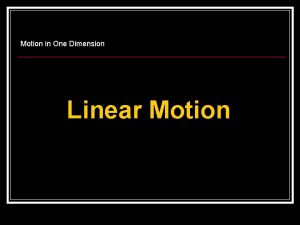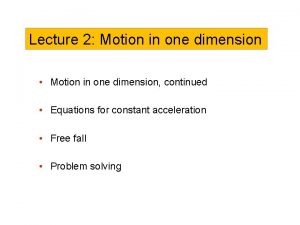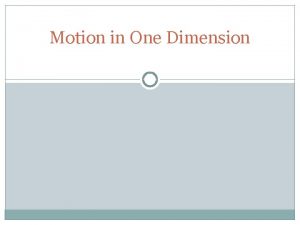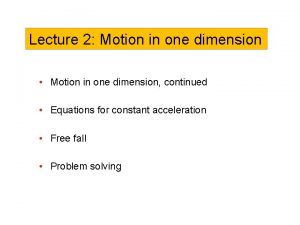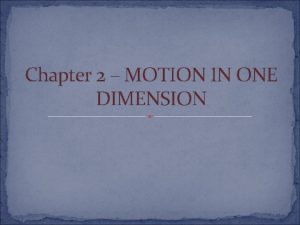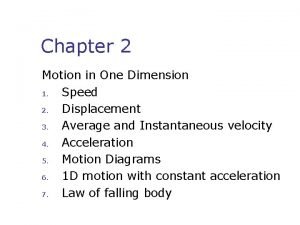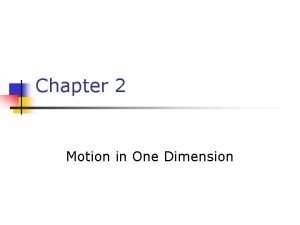CHAPTER 2 MOTION IN ONE DIMENSION Motion One




































- Slides: 36

CHAPTER 2 MOTION IN ONE DIMENSION

Motion One dimensional motion is the simplest form of motion – Ex: a MARTA train traveling down the tracks Frame of reference – a system for specifying the precise location of objects in space and time

PHYSICAL QUANTITY SCALAR • can be completely specified by its magnitude with appropriate units. • It has no direction. • E. g. Distance, time, speed, mass, etc.

PHYSICAL QUANTITY VECTOR • Has a magnitude, a unit and a direction • e. g displacement, velocity, acceleration, force.

COMPARISON DISTANCE - is a scalar quantity. It is represented by a magnitude and a unit. 10 km DISPLACEMENT- is distance with a direction. It is the shortest distance between the beginning and the end of a journey. It is represented by a magnitude, unit, and direction. 10 km 300 NE

Displacement ∆ x = x f – xi Displacement = final position –initial position ∆ - delta or change in position Xf – final position Xi – the initial position

DISTANCE The length of the actual path between the initial and final positions of the particle is called the distance covered by it. D B A C Distance covered = AB + BC + CD

DISPLACEMENT The vector drawn from initial position to final position is called displacement. It has a magnitude and a direction. A B C Displacement = AD Displacement = Final Position Initial Position D

COMPARISON SPEED - is a scalar quantity. It is represented by a magnitude and a unit. 10 km/h VELOCITY - is speed with a direction. It is represented by a magnitude, unit, and direction. 10 km/h 300 NE

SPEED v. Speed is a measure of how fast something is moving. v. Speed is distance covered per unit time. v. SI unit is meter/second (m/s) v. Other units: km/h, miles/h etc.

VELOCITY Velocity describes the speed and direction of an object. It is a vector quantity, since it has a magnitude and a direction. E. g. object moving 30 miles/h due south.

VELOCITY Velocity is the rate at which an object changes its position.

Velocity Vavg = ∆x / ∆t Vavg = xf-xi / tf-ti

REPRESENTATION OF A VECTOR A Tail A Head The direction of the arrow indicates the direction of the vector quantity. The length of the arrow indicates the magnitude of the vector quantity.

ADDING VECTORS -ONE DIMENSIONAL Vectors are added by placing the tail of one vector at the head of the other vector. A third vector (C) is drawn by placing the tail of one vector at the head of the other. A B C

EXAMPLES 200 m 100 m 300 m-resultant 50 m 30 m 20 m-resultant

MOTION Motion is: • change in position • change in time • change in speed • change in distance

AVERAGE SPEED


INSTANTANEOUS SPEED is speed at any given instant in time.

SIMPLE CONVERSIONS

EXAMPLE Your neighbor says she can skate at a speed of 4 m/s. To see if you can skate faster, you have her time you as you skate as fast as you can for 100 m. Your time is 20 s. Who skates faster?


EXAMPLE A person traveled 200 km at 50 km/h and then traveled 300 km at 60 km/h. What is the average speed of the person?


DISTANCE TIME GRAPH Makes it possible to “see” the motion of an object over a period of time. The slope of a distance time graph for an object in motion gives the speed of the object. The steeper the slope the greater is the speed of the object.

DISTANCE TIME GRAPH Distance (m) 25 20 15 10 15 20 Time (s) 25 30

Distance (m) WHICH RUNNER HAS THE GREATER SPEED? 25 Runner #1 20 15 10 Runner #2 5 0 5 10 15 20 25 Time (s) 30

Position Time Graph is a graph with position plotted on the vertical (y) axis, and the time plotted on the horizontal (x) axis. It is used to find the instantaneous velocity of an object. The slope of the tangent to the curve at a particular point is called the instantaneous velocity at that instant. (What? !)


Slope of Tangent is Increasing --- the object’s velocity is increasing

Positive Constant Velocity Positive Increasing Velocity

Negative Velocity: An object moving toward less positive position has a negative velocity. E. g an object moving from 30 m to 20 m may have a velocity of -10 m/s

Negative Velocity:

Slow-Fast Increasing Velocity Fast-Slow Decreasing Velocity

Positive Velocity: An object moving toward more positive position has a positive velocity. Example: an object moving from 20 m to 30 m has a velocity of 10 m/s.
 Vf-vo
Vf-vo Motion in one dimension quiz
Motion in one dimension quiz Constant speed tape chart
Constant speed tape chart Holt physics chapter 2
Holt physics chapter 2 Free fall motion in one dimension
Free fall motion in one dimension Motion in one dimension
Motion in one dimension Describing motion kinematics in one dimension
Describing motion kinematics in one dimension Describing motion kinematics in one dimension
Describing motion kinematics in one dimension Vo
Vo Mathematical techniques
Mathematical techniques Forces in one dimension chapter 4
Forces in one dimension chapter 4 Chapter 4: forces in one dimension answer key
Chapter 4: forces in one dimension answer key Frequency of oscillation
Frequency of oscillation Chapter 2 section 1 describing motion answer key
Chapter 2 section 1 describing motion answer key What is acceleration
What is acceleration Section 1 describing motion
Section 1 describing motion Vectors
Vectors To describe a position in more than one dimension
To describe a position in more than one dimension Undefined terms and basic definitions worksheet answers
Undefined terms and basic definitions worksheet answers Dimension in research
Dimension in research Representing motion physics
Representing motion physics One empire one god one emperor
One empire one god one emperor One one one little dogs run
One one one little dogs run One king one law one faith
One king one law one faith One empire one god one emperor
One empire one god one emperor One team one plan one goal
One team one plan one goal See one do one teach one
See one do one teach one See one, do one, teach one
See one, do one, teach one Twelfth night speeches
Twelfth night speeches Studiendekanat uni bonn
Studiendekanat uni bonn Asean tourism strategic plan
Asean tourism strategic plan Asean one vision one identity one community
Asean one vision one identity one community Range of motion active and passive
Range of motion active and passive What is the formula of simple harmonic motion
What is the formula of simple harmonic motion An object in motion stays in motion
An object in motion stays in motion Section 1 describing motion answer key
Section 1 describing motion answer key Motion section 1 describing motion
Motion section 1 describing motion

